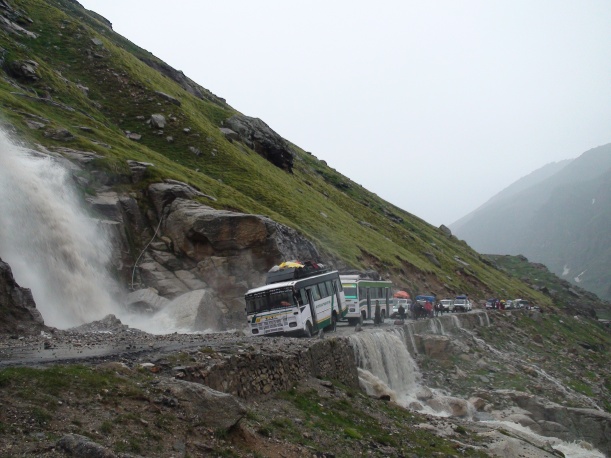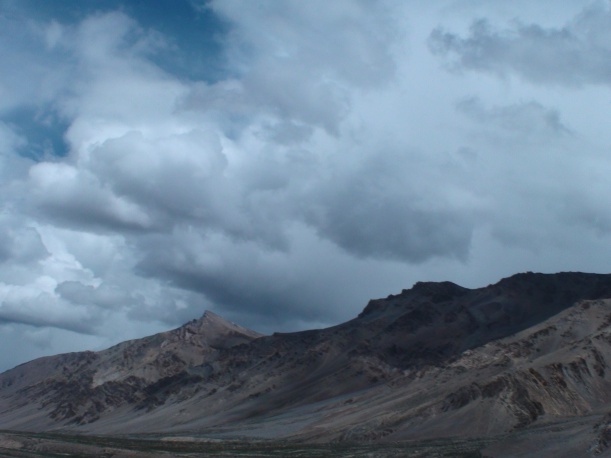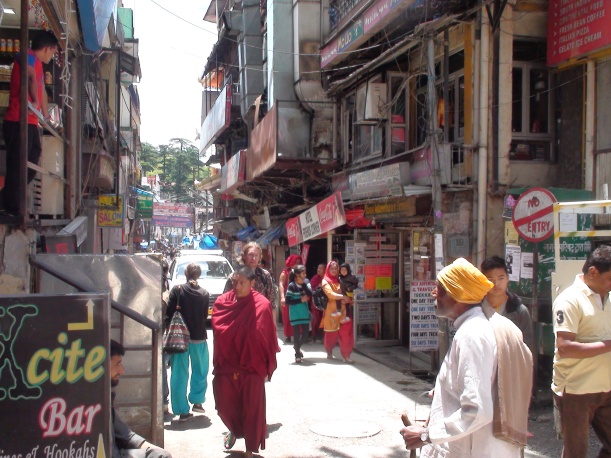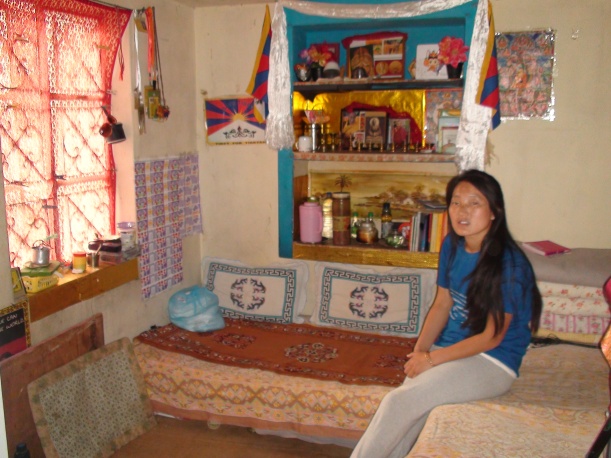Bus Me to the Moon
Sorry I didn’t post more pictures of where I stayed, etc. The internet isn’t so lightning quick here… anyway, this should give you some idea, and perhaps I’ll post more photos next time. Enjoy!
Ladakh’s landscape hit my eye with a gentle welcome each morning as I sauntered out of my homestay and made my way to the Kalachakra teaching ground. I came to feel so cozy with the fortress-like walls of mountain encircling the entire Leh region. But on first encounter, I was not impressed. It seemed that this is how it must be on the moon. Just giant rocks jutting up all over. Ladakh is barren earth.
I started out cold, tired, and grumpy on the 2-day voyage into Ladakh. I don’t use the word voyage lightly – of course, it wasn’t by nature something grand and exciting. The word here is just being used relative to the amount of effort I had to exert to keep my mind calm when it was on the brink of going bonkers.
There weren’t actually any major obstacles or discomforts. A few little road obstructions came up.
But how easy is it to overreact to little things? So I spent much of my travel time baby-talking myself into remembering to be grateful for the incredible skill of the drivers who traverse these paths and whoever mustered the courage to even come here in the first place, and then build roads for everyone else to be able to visit. Luckily, the other people around me were so easy-going and unphased by whatever was going on that it acted as an immediate reminder for me the moment I started to steam. “Wait a minute – why is everyone around just hanging out, laughing and enjoying themselves, while I’m turning this into a hellish dream? I’m not making any sense!”

Yes, I actually had genuine fear at a few points on the trip… rocks were being shot down from the waterfall above as I fear we would sink to our doom in the four-foot hole in this road-river. But, no need for a tow truck or police intervention – another bus towed ours out and we were on the way, whence all the bystanders who were waiting from other vehicles began hurling rocks to fill in this hole. That’s teamwork!
The reactions of my companions were representative of a cultural attitude for which my fondness grows the longer I stay here. It’s acutely summarized by a seemingly meaningless interaction I witnessed in a cybercafe in Leh (the capital city of Ladakh). The internet wasn’t working well and a young man walked up to the shop’s propietor – “Oh, internet still not working? Oh well… what’s there to do?” she said. Then, though normally that rhetorical question is the capstone of a expression of empathy, here there was just a moment’s pause after which she said with bizarre enthusiasm, “Nothing!”
I’m wondering how to merge this lack of expectations and frustrations with a wisdom-based energy that seeks to overcome actual problems and bring more ease and joy to people’s lives. This latter attitude appears to be weak in India! What kind of statement might follow “What’s there to do?” if both of these attitudes were combined?
In a way, it’s quite excellent to have some obstacles – whether real or imagined – when bringing oneself towards an activity of great spiritual merit. It helps to call up some determination and recollect the greater purpose for which we engage in a spiritual pursuit. And I certainly had not decided to come to this no longer so remote Himalayan land in order to go trekking or sightseeing.

This was a neat temple, with both Hindu and Buddhist images. The sign on the right reads “Taglanga: Altitude 17582 FT – You Are Passing Through Second Highest Pass of the World. Unbelievable Is Not It?” That’s not my typo 😉
Training to See Reality
So then, why had we come all this way to sit under the hot sun with headphones on? There were 150,000 people, pilgrims really, including about 7,000 foreigners, 9000+ monks and nuns, and purportedly 100 Tibetans who came from Tibet itself – I shared a cab with two of them, who said it took fifteen days to get there. We came to learn how to fuel the spark of peace that lies in the mind of each one of us. What better way than to hang around and listen to a so-called Champion of Peace – His Holiness the Dalai Lama?
He’s already won peace. For the rest of us, it’s a small itch, easily ignored or overlooked. But, I believe, the more we hear about how wonderful the grand prize is – the bliss of awakening – the more it becomes a yearning, and then a burning, blazing insatiable need to make genuine inner transformation. We’re tugged along from within our hearts like magnets to learn, contemplate, and meditate on the meaning of compassion and interdependence.
And it really works. I was treated to the results of other people’s aspirations to compassion everywhere I turned. I stayed with a local family only a few kilometers from the teaching ground. I discovered them through the Kalachakra website, where they, and several hundred other families, listed their homes as a free homestay for visitors. But it wasn’t just a room they offered – they constantly served me, as if I were some honored guest, giving me food and drink and even heating water for me to have a hot bath (since there was not on-demand hot water at their home).

The girl is Dedrol, the older boy is Odga, and I forget the baby’s name. These kids are so sweet, and it was beautiful to hear this four-year-old girl perfectly chant Tibetan prayers
They also hosted five college students from Delhi who are studying religion and came to Kalachakra to learn about this Buddhist practice. Clearly space is a little different here than in Mcleod, much as it is in the States when we compare a dense city to the open country. This house had four totally unoccupied, very spacious rooms.

Momo party! The Indian guests making momos (Tibetan style dumplings) with two of our Ladakhi hosts (Tashi with the red scarf is the mother of the kids)
The Indian students kept calling the Kalachakra a festival – an indication that there may have been something lost in translation, and no doubt lost in the cultural fair that indeed most Himalayan people in attendance did appear to treat it as. I found it a little sad how much they lacked in their Buddhist education limited how much they could benefit.
At one point fairly early on, His Holiness actually asked for a show of hands among the Ladakhis of how many of them understood the Ladakhi translation. With all of the technical Buddhist vocabulary (most of which remained in the Tibetan anyway, as Ladakhi is quite similar) very few raised their hands. For the rest of the teachings, His Holiness didn’t even have his words rendered into Ladakhi. Us listening to the English via FM transmission were incredibly lucky, especially given the skill and expertise of the translator Tenzin Tsepak. I heard from several non-native English speakers that it was much easier to listen to the English because of the skill of the translator.
If you’re actually wondering what Kalachakra is, I still don’t know about it well enough to explain it myself – it’s a complete Buddhist system of philosophy and practice, unique yet firmly situated within the more general teachings of Buddha. It can lead individuals to utterly remove whatever inwardly obstructs the mind from blissful and heart-embracing connection with all living beings.
Luckily, two different Kalachakra masters were giving extra explanatory teachings each day during this event. Both commented on the essence of Kalachakra – 1) the happiness of all living beings and 2) harmony. It is also connected with benefiting society and purifying the environment, so it seems especially suitable for us today. (For more explanation, you can read His Holiness’ own comments here: )
One of the the pieces of advice that His Holiness gave us from the very first day was to be kind towards one another. It was obvious that people put sincere effort into carrying this out this instruction. It created a communal atmosphere unlike that which one can expect to find in this crazy world. I befriended a Russian woman who had a near-constant stock of bananas and nuts, and was truly happy to always share. I had little problem getting around – I stuck my hand out and within minutes would get picked up, sometimes by shared taxis, but often just by locals who wanted to help.
Though an air of love hung just below the reach of tactile awareness, I can’t pretend that it was a Utopian paradise. One day I was walking to meet a friend through the outdoor seating area, strewn with mats and cushions, when suddenly I looked up to a scowl so perversely out of place I had to work to try to put on a demeanor of seriousness: “You do not walk on my mat with your shoes on! Take your shoes off – it’s common courtesy!” my new friend remarked. Alas, this is exactly why we were there. Were we already perfect, there’d be no for anyone to come.
Spirits Come to Say Hi
I was also quite intrigued to witness several visitors come from “unseen realms.” During His Holiness’ birthday celebration and again on the very last day during a long-life prayer for him, several “possessions” occurred. I think I counted eight in total.
One happened just two rows behind where I sat. It appeared to be incredibly uncomfortable for the possessed person. I first heard some muffled screams separated by several seconds of silence. Then, “Stop, stop! No, no!” Then, well, it basically looked like the scene out of the “Exorcist,” minus the split-pea. A few quick-thinking and brave souls restrained her and carried her to the stage, whereupon she was brought right in front of His Holiness. Like something out of Harry Potter – wearing a majestic yellow hat that curves back into a point like an elve’s, His Holiness waved his hands towards her with a gentle, deliberate force and a flick of the wrist a couple of times. No need for a wand. She fell limp. She was brought back to her seat, where she seemed to quickly recover.
Granted, there are some big differences between Harry Potter and Buddhism – even though many of the magical powers run parallel, in Buddhism the only enemies are on the inside. There are no external enemies, only people who do harmful actions because of being so overwhelmed by their own inner enemies. If we really check, who actually was the enemy in Harry Potter anyway? Was it Voldemort or the jealousy, pride, and hatred within his mind? That’s only a story, but isn’t it also true in real life? Which part of Bin Laden was genuinely responsible for so much harm – his body, his voice, his grimacing eyes… Or the distorted thinking that overwhelmed his every intention?
The explanation of what was happening with these possessed people was that there were many other beings with us this whole time whom we cannot see. When we’re praising and praying for His Holiness, some of them get excited and want to come give praises, too! Who can blame them?
So there was excitement, there was inner growth, friendships were deepened and new ones formed, and it all occurred within the stream of moments of mind that give an appearance of seamless permanence. In reality, this mind is but a cascade of awarenesses blipping in and out of existence. And reflecting on impermanence in this way can fuel a true sense of inner freedom and strengthened capacity to contribute to others, since we stop worrying so much about every little problem that comes up, thinking it’s the end of the world. In a way, every moment is the end of the world. So too is it the beginning. We can stay always fresh to respond with a positive energy, no matter what comes.
The Main Point – Wisdom
Since the real point of being at the Kalachakra for world peace was to understand more deeply the nature of reality and use that wisdom to help others, I’ll share some of the practical spiritual advice given by His Holiness. He taught us two texts by the great 2nd century master Nagarjuna, both originally written as advice to a king. These – the “Precious Garland” and the “Letter to a Friend” – are treasure troves of gems of simple wisdom (these verses aren’t in order, they’re just some of my favorites):
“There may be pleasure in scratching an itch —
Yet more pleasurable is its absence. Just so
The world of desire gives pleasure, yet absence
Of desire is a greater pleasure still.”
“The teacher of gods and men declared that being satisfied
Was the greatest of all riches. Remain
Satisfied always. One knowing satisfaction is
Truly wealthy, even without material possessions.”

A 450-year-old, 11.5-meters-tall Buddha statue at Shey Palace. Really blessed place, and so nice to see these old monasteries, which you can’t find in most parts of India.
“Even more stupid than one who fills
a jewel-embellished gold vessel with
Excrement is one who, having been born
A human, performs evil deeds.”
“Understand thoughts as being like figures
Drawn in water, earth, and stone.
For an afflicted state of mind the first is best;
With an aspiration for the Dharma, the last.”
“Recognizing wealth to be ephemeral and insubstantial,
Exert yourself properly in liberal acts
Towards bhikshus, Brahmans, the poor, and friends.
For the future there’s no better friend than generosity.”
I leave you with these words and the wish that we may all shun harmful deeds, let water-drawings of ghouls dissolve as they appear, always enjoy true wealth and pleasure, and make reliable friends.
Now, I am back in school – it’s been a while! I’m quite relieved, since I made it here safely and I feel very happy with my situation here. Learning ho!!!
Your Friend,
Jon















